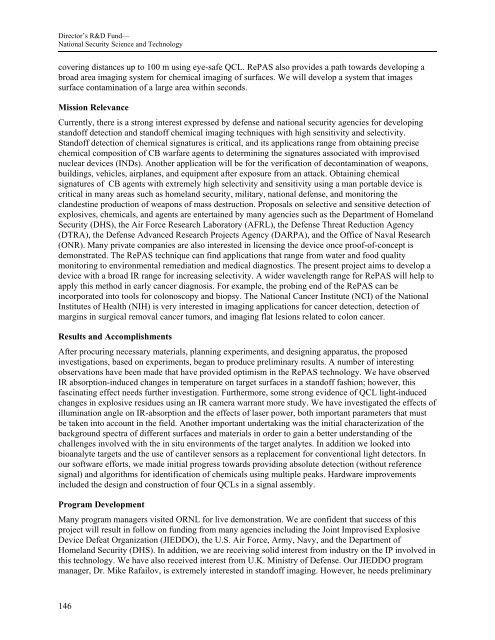FY2010 - Oak Ridge National Laboratory
FY2010 - Oak Ridge National Laboratory
FY2010 - Oak Ridge National Laboratory
Create successful ePaper yourself
Turn your PDF publications into a flip-book with our unique Google optimized e-Paper software.
Director’s R&D Fund—<br />
<strong>National</strong> Security Science and Technology<br />
covering distances up to 100 m using eye-safe QCL. RePAS also provides a path towards developing a<br />
broad area imaging system for chemical imaging of surfaces. We will develop a system that images<br />
surface contamination of a large area within seconds.<br />
Mission Relevance<br />
Currently, there is a strong interest expressed by defense and national security agencies for developing<br />
standoff detection and standoff chemical imaging techniques with high sensitivity and selectivity.<br />
Standoff detection of chemical signatures is critical, and its applications range from obtaining precise<br />
chemical composition of CB warfare agents to determining the signatures associated with improvised<br />
nuclear devices (INDs). Another application will be for the verification of decontamination of weapons,<br />
buildings, vehicles, airplanes, and equipment after exposure from an attack. Obtaining chemical<br />
signatures of CB agents with extremely high selectivity and sensitivity using a man portable device is<br />
critical in many areas such as homeland security, military, national defense, and monitoring the<br />
clandestine production of weapons of mass destruction. Proposals on selective and sensitive detection of<br />
explosives, chemicals, and agents are entertained by many agencies such as the Department of Homeland<br />
Security (DHS), the Air Force Research <strong>Laboratory</strong> (AFRL), the Defense Threat Reduction Agency<br />
(DTRA), the Defense Advanced Research Projects Agency (DARPA), and the Office of Naval Research<br />
(ONR). Many private companies are also interested in licensing the device once proof-of-concept is<br />
demonstrated. The RePAS technique can find applications that range from water and food quality<br />
monitoring to environmental remediation and medical diagnostics. The present project aims to develop a<br />
device with a broad IR range for increasing selectivity. A wider wavelength range for RePAS will help to<br />
apply this method in early cancer diagnosis. For example, the probing end of the RePAS can be<br />
incorporated into tools for colonoscopy and biopsy. The <strong>National</strong> Cancer Institute (NCI) of the <strong>National</strong><br />
Institutes of Health (NIH) is very interested in imaging applications for cancer detection, detection of<br />
margins in surgical removal cancer tumors, and imaging flat lesions related to colon cancer.<br />
Results and Accomplishments<br />
After procuring necessary materials, planning experiments, and designing apparatus, the proposed<br />
investigations, based on experiments, began to produce preliminary results. A number of interesting<br />
observations have been made that have provided optimism in the RePAS technology. We have observed<br />
IR absorption-induced changes in temperature on target surfaces in a standoff fashion; however, this<br />
fascinating effect needs further investigation. Furthermore, some strong evidence of QCL light-induced<br />
changes in explosive residues using an IR camera warrant more study. We have investigated the effects of<br />
illumination angle on IR-absorption and the effects of laser power, both important parameters that must<br />
be taken into account in the field. Another important undertaking was the initial characterization of the<br />
background spectra of different surfaces and materials in order to gain a better understanding of the<br />
challenges involved with the in situ environments of the target analytes. In addition we looked into<br />
bioanalyte targets and the use of cantilever sensors as a replacement for conventional light detectors. In<br />
our software efforts, we made initial progress towards providing absolute detection (without reference<br />
signal) and algorithms for identification of chemicals using multiple peaks. Hardware improvements<br />
included the design and construction of four QCLs in a signal assembly.<br />
Program Development<br />
Many program managers visited ORNL for live demonstration. We are confident that success of this<br />
project will result in follow on funding from many agencies including the Joint Improvised Explosive<br />
Device Defeat Organization (JIEDDO), the U.S. Air Force, Army, Navy, and the Department of<br />
Homeland Security (DHS). In addition, we are receiving solid interest from industry on the IP involved in<br />
this technology. We have also received interest from U.K. Ministry of Defense. Our JIEDDO program<br />
manager, Dr. Mike Rafailov, is extremely interested in standoff imaging. However, he needs preliminary<br />
146
















